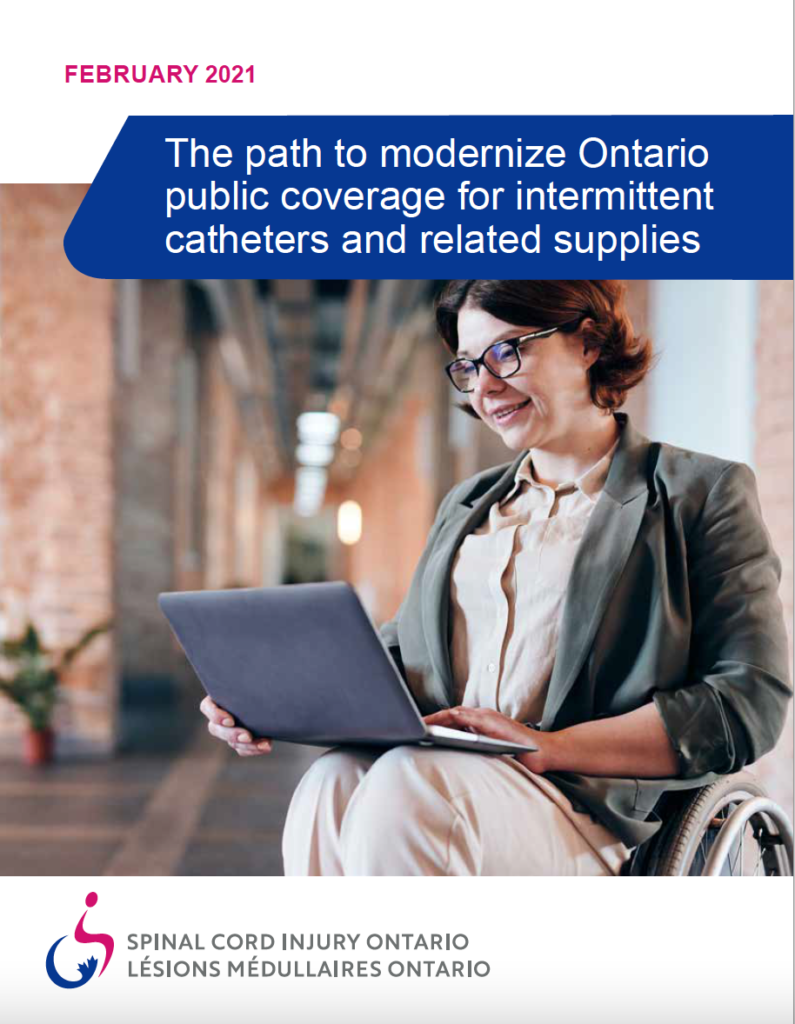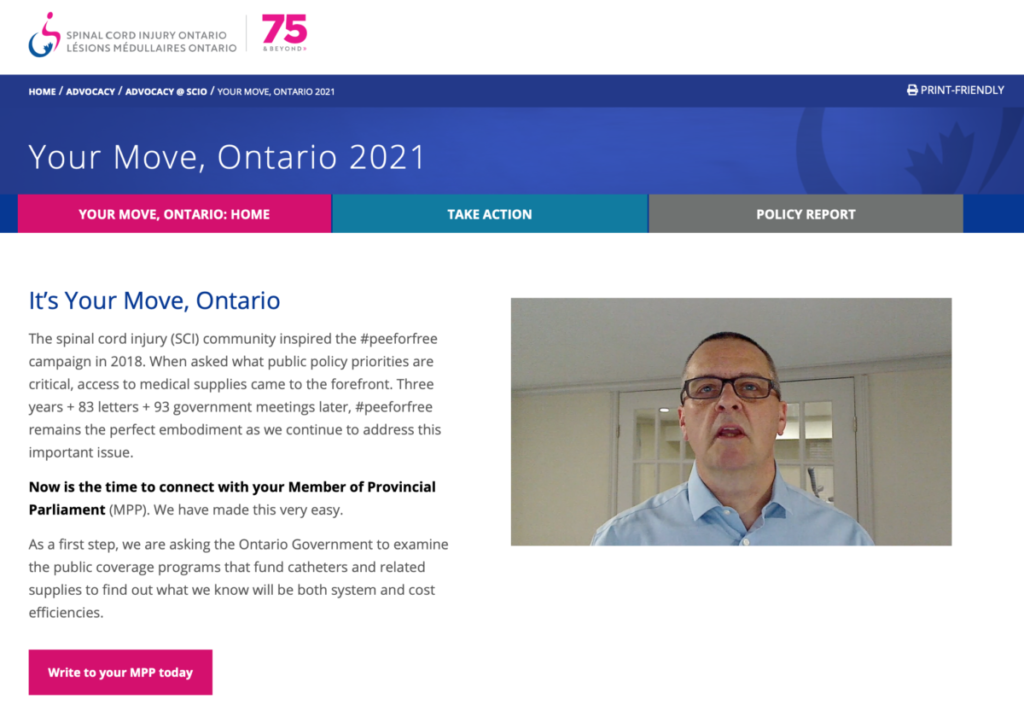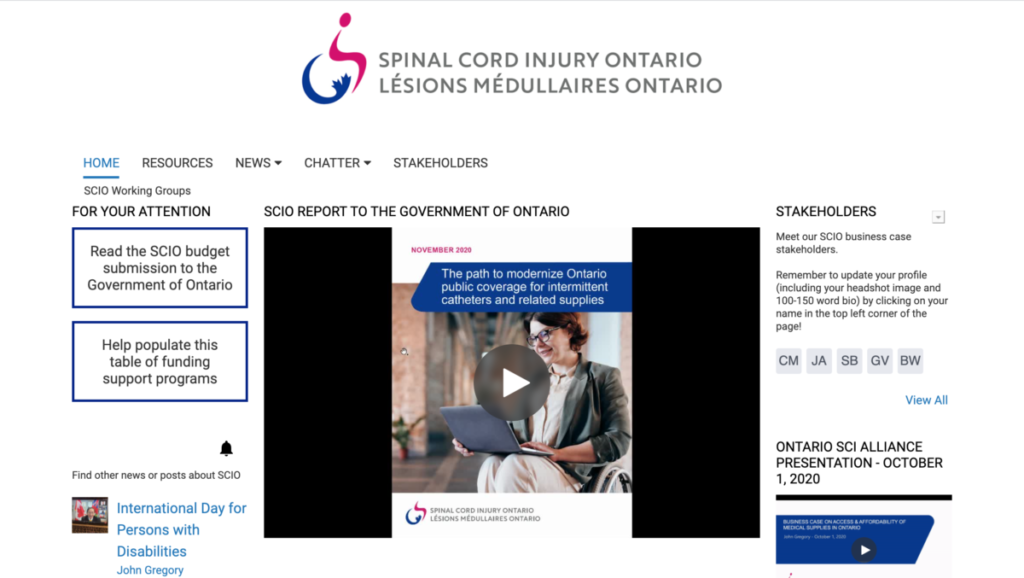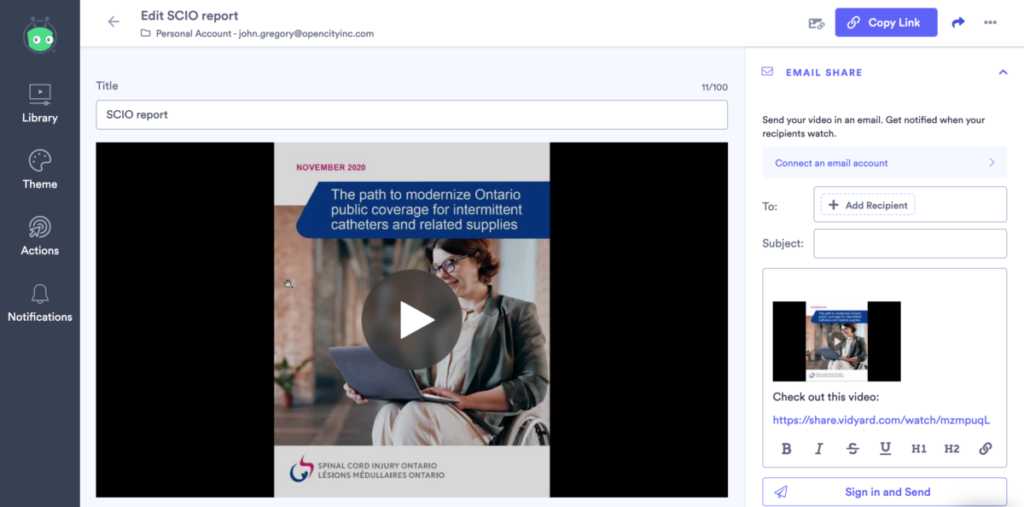A broad stakeholder group working through 2020 brought attention to the 33,000 people who use intermittent catheters every day in Ontario.
Individuals with a neurological condition, including a spinal cord injury (SCI), may not be able to empty their bladder on their own, which can lead to chronic urinary retention and serious health problems such as bladder damage or kidney disease. To prevent these problems from happening a catheter is used up to five times a day to drain the bladder, a process called intermittent catheterization. Here we explore a case study about the development and production of the policy report on behalf of Spinal Cord Injury Ontario.
“I believe comprehensive catheter coverage for Ontarians is an issue of equity and respect. Based upon best evidence, we should not expect patients to reuse single-use medical products, like intermittent catheters,” explains Dr. Dean Elterman. “Our catheter coverage lags behind the rest of the industrialized world, and our patients deserve better.”
9 policy report core recommendations
To support a person’s ability to access enough intermittent catheters, a modern public coverage model is needed. The report visualizes a new streamlined program to improve patient access.
The policy report proposes nine recommendations to the Government of Ontario with a path forward for modernizing the funding available for individuals needing to use intermittent catheters and related supplies. If implemented, government programs will reduce red tape, improve procurement practices, achieve greater value for the government and provide people with what they need; simply and efficiently.

- Conduct an examination of the overlapping government programs for intermittent catheters to uncover hidden costs and opportunities to reduce red tape.
- Prioritize the implementation of a new modern funding program for intermittent catheters that delivers system and financial efficiencies for better patient care.
- Leverage best practices from other jurisdictions, e.g., Saskatchewan style program via approved distributors.
- Procure for a comprehensive medical supply coverage program that both allows for consistency of product choice through the continuity of care and prevents patients from needing to reuse single-use catheters.
- Support the Health Canada, nursing and physician position that single-use catheters should not be reused as they are approved to be used only once and then discarded.
- Ensure access to specialty nurses with knowledge, skills, and judgment in bladder health and continence.
- Improve the hospital to community transition of Indigenous Ontarians who have suffered a spinal cord injury or other health conditions that cause bladder dysfunction.
- Increase access to specialist nurses to improve assessment and timely access to products and supplies by filling out and submitting forms correctly.
- Determine how to better support Ontarians who work seasonally and who may have limited access to current funding information.
“Sustainable health policy innovation is best achieved when multiple stakeholders, people with lived experience, and system experts work in equal partnership. Modernizing evidence and best practice on access to catheters and other urinary supplies would not have been as successful without a high level and rigorous group of 100+ people in the field working on common goals.”
Peter Athanasopoulos
The policy report contains six principal sections. In addition, four narratives were developed to add a name and face to the stories.
- Funding pathways for intermittent catheters and related supplies – There are a plethora of intertwined programs that have not been designed with people at the centre in the Province of Ontario. Different programs managed by different government agencies are layered one upon another. This complexity creates wasteful administration meaning modernization is warranted so that the criteria are simple and effective.
- Latest economic analysis – The estimation on the impact of hydrophilic catheters on lost time to receive treatment for urinary tract infections (UTI) suggests that providing people requiring intermittent catheterization with a choice of hydrophilic catheters would result in potential long-term cost savings to the Government of Ontario.
- User experience and the impacts of COVID-19 – The estimation on the impact of hydrophilic catheters on lost time to receive treatment for urinary tract infections (UTI) suggests that providing people requiring intermittent catheterization with choice of hydrophilic catheters would result in potential long-term cost savings to the Government of Ontario.
- Meeting the needs of Indigenous & rural populations – What happens in Toronto is vastly different than the experience of people in northern Ontario communities. The needs of Indigenous peoples and rural communities deserve improved community transition and access to specialist nurses.
- Clinical best practice recommendations – The Canadian Urological Association (CUA) and Nurses Specialized in Wound, Ostomy & Continence Canada (NSWOCC) have both published new 2020 clinical recommendations. They state that they cannot support the reuse of catheters licenced for single use in any setting.
- Health Canada single-use medical devices – Collectively, the industry members represented through Medtech Canada have developed a position paper calling for the Government of Ontario to address patient safety and potential liability risks associated with individuals for financial reasons having to reuse catheters.
Take Action at Your Move, Ontario 2021
What became apparent in research these programs is that they have not been designed with people at the centre in the Province of Ontario. Different programs managed by different government agencies are layered one upon another.
Government relations
The goal of the project was to influence the Government of Ontario to improve the accessibility and affordability of intermittent catheters and related supplies. The policy report provided a backbone to that case and mobilized stakeholders building upon the former 2018 campaign #peeforfree and asking people in Ontario to write to their MPP.
Our objective Is to modernize the funding programs for people with disabilities in accessing medical supplies in the next provincial budget through a comprehensive evidence-informed business case guided by people who require these medical supplies to live healthy and productive lives. This critical work will reduce secondary complications through greater affordability and access to essential bladder management devices for those who are vitally dependent on them.”
Peter Athanasopoulos
The consequences of doing nothing are far more severe to a person’s health and the economy when the system of services available for intermittent catheters is inefficient.
In parallel to this policy report development, Min Xi & Brian Chan worked on an updated health economic analysis. This is now published in BJU International Open access, available here.
The featured image of the report infographic was intended to rapidly communicate why this warrants attention by the Government of Ontario. We support the SCIO team with copy writing the content for the Your Move, Ontario 2021 webpage.

Take Action at Your Move, Ontario 2021
Digital workplace
During the scoping of the project, it was anticipated that a two-day workshop would take place in person in May 2020 to brief stakeholders. We had to quickly adapt to conducting the whole project remotely. From positive experience with running leadership summits, we pitched the Igloo Software as the ideal digital workplace to engage stakeholders.
“While COVID put challenges forward in achieving our multi-stakeholder approach to health policy innovation, shared learning technology like Igloo Software and virtual meeting software like Zoom certainly helped us maintain progress towards our recommendation to modernize public coverage of catheters and urinary supplies in Ontario.”
Peter Athanasopoulos
Video played a substantial part in the policy report development as well as in the Your Move, Ontario 2021 site. The Vidyard video platform allowed regular videos to be embedded into the Igloo portal to guide the stakeholders on the next actions they were encouraged to take. Transcripts from the Zoom sessions were taken using the transcription app Trint and which formed the foundation of the report.

Here is an example of the video used to help orientate stakeholders in how to use the SCIO Igloo portal.


5 lessons from the development of the policy report
Project management remains a balance between sticking to the intended scope of a project while maintaining flexibility to adjust to the demands of a project. The lockdowns from the pandemic came into place less than a month into this project. Here are five lessons from this policy work with SCIO:
- engage a broad range of stakeholders, including patients or parents of children impacted by the need;
- dig into the detail of generic statements such as how many funding programs are available. Map them out on paper and get expert insight to fact-check;
- establish best practices for running effective Zoom sessions through scripting and clear presenter briefing;
- harness embedded video to increase the open rate of emails with simple actions;
- clearly define the document structure before investing time in writing and copy editing, using tools such as PerfectIt to improve accuracy.
This project mixed individuals with whom we had worked previously with building new relationships with members of the steering committee and working groups. Congratulations to Peter and the whole team working for those dependent on intermittent catheters and related supplies for their bladder health. The significance of this work extends far beyond Ontario.
One of our Charity Spotlight features in 2020 showcased Spinal Cord Injury Ontario. Opencity Inc. thinks giving a spotlight to charities is important and one way we can be socially responsible.

